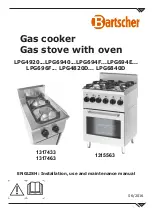
A false reading of the temperature may be caused by heavy food soiling, residual oven cleaner on the thermostat
and/or the roof elements, or a dislodged thermostat phial. Cleaning should be carried out regularly and with care.
Always disconnect the electricity supply to the appliance before any cleaning takes place.
Never allow fat or oil to build up on any surface, particularly on oven bases and oven trays, as this can lead to
permanent staining or the risk of fat fires.
We recommend the use of E-cloth® products. These micro fibre cloths will keep your Britannia cooker smear, finger and
water mark free using the minimum of effort and chemical cleaners. Call 0871 871 8680 to purchase your E-cloth®.
Cleaning your gas hob
Stainless steel hob
Do not use any abrasive cleaners on the stainless steel hotplate.
Wipe with a soft cloth using warm water and washing-up liquid. Whilst still damp polish dry with an E-cloth®.
For stubborn cooked-on stains use a non-abrasive stainless steel cleaner.
Always work in the same direction as the grain of the stainless steel, rinse well and polish dry.
Pan supports
Pan supports and burner caps are made from cast iron with a protective coating of acid resistant enamel, and must
not be put in a dishwasher.
Always allow pan supports and burner caps to cool completely before immersing in water.
Wipe with a soft cloth using warm water and washing-up liquid.
For stubborn marks use a cream cleaner applied with a nylon scourer. Rinse well and dry, before replacing on the
hotplate.
When placing the pan supports on the hotplate, the widest edge of the cast iron faces to the outside left or right.
Burner rings:
Use a cream cleaner and a nylon scourer. Rinse well and dry.
After cleaning, ensure that the burner slots are dry and not blocked.
Alloy burner bases:
Never put the alloy bases in a dishwasher as the salt may damage the alloy.
Always ensure that no other metals are in the same water as the alloy bases as electrolysis may occur, blackening the
alloy. Wipe clean with a soft cloth, warm water and washing-up liquid.
For stubborn marks use a cream cleaner on a soft damp cloth.
Rinse and dry before replacing on the hotplate.
An alloy metal polish is available to buy from Britannia. See Accessories on page 36 or call 0871 871 8680.
When re-assembling the burners, always ensure that the notches on the burner ring are seated firmly into the base
for the gas to ignite and the flame to be stable. (See burner assembly instructions on page 6).
Chef Top:
As the Chef Top is heavy we recommend that you clean it on the hob without moving it.
After cooking, allow the Chef Top to cool until just warm.
Use a spatula to remove any cooking residue.
Wipe away any fat in the drip tray with kitchen towel.
Clean the whole surface with warm water and washing-up liquid, using a stainless steel scourer. Always work with the
grain of the stainless steel.
Some foods with a high salt content (such as bacon) may leave white marks. For these and other stubborn marks use a
cream cleaner suitable for stainless steel surfaces.
TM
To reduce cleaning requirements we recommend using our Bake-O-Glide Chef Top liner.
Call 0871 871 8680 for more information.
32
Cast iron griddle:
The cast iron griddle will absorb oils as it is used. Over time it will develop a
natural non-stick finish.
After cooking, scour the griddle whilst still warm with warm water, and dry
immediately.
Rub a little olive oil into the cooking surface to protect the cast iron while
not in use.
Avoid using detergents as this will remove the natural non-stick coating. Do
not clean in a dishwasher.
Cleaning your induction hob
Allow the hotplate to cool down until the residual heat indicator is
extinguished before commencing any cleaning. Never use scouring powders
or paste, metal scourers, oven cleaners or any abrasive cleaning products on
the hotplate. It is important that any spillage is cleaned from the hotplate
before it is used again.
For light soiling, wipe with a soft cloth, warm water and washing-up liquid.
For a streak free finish, polish dry with an E-cloth®.
For more stubborn marks and to condition the surface, use a good quality
hob cleaner/conditioner, following the manufacturer's instructions.
For spillages with a high sugar content (such as jam) or the accidental
melting of plastic or alloy materials, turn off the hotplate and remove the
spillage immediately. Take care as the hotplate and the spillage will be very
hot.
Fascia, controls and external surfaces
Do not use strong or abrasive cleaning agents or materials on the controls,
fascia panel or coloured cooker surfaces. This can cause damage to the
calibrations and icons and permanently scratch the surfaces.
Coloured surfaces:
Clean with a soft cloth, warm water and washing-up
liquid. Whilst still damp, polish dry with an E-cloth®.
Stainless steel:
For stubborn marks use a reputable non-abrasive stainless
steel cleaner. Always work with the grain of the stainless steel, rinse well and
polish dry with an E-cloth®.
Glass:
Clean with a soft cloth, warm water and washing-up liquid. Difficult
marks on the glass can be removed using a cream cleaner. Never use sharp
implements to remove marks as this could scratch the glass.
Ovens:
Always allow the oven interior to cool before cleaning.
Interior oven door enamel and glass:
Never use sharp implements to remove stains as this could scratch the
surface. The door enamel and glass surfaces can be cleaned with a soft cloth,
warm water and washing-up liquid. Polish dry with an E-cloth®. For more
stubborn marks and to protect the glass surface use a good quality glass
cleaner/conditioner, following the manufacturer's instructions.
Please do not use steam cleaners on the oven interiors as this may affect
electronic parts.
33
Cleaning your cooker
Cleaning your cooker









































